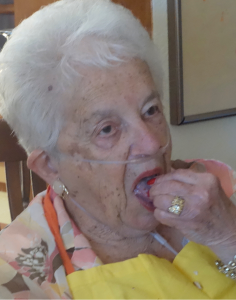Chapter 4: Treatment of Swallowing Disorders
 Treatment of dysphagia may be addressed by a variety of medical professionals. This chapter will focus on approaches used by speech-language pathologists to treat swallowing and feeding disorders. In this chapter we will address the importance of oral hygiene, as well as describe compensatory treatment strategies, environmental supports, and rehabilitative approaches that will improve swallow safety and efficiency. Ideally treatment should be aimed at providing the least restrictive, and the safest and most efficient swallow allowable, while meeting the desires and goals of the patient such that they willingly and consistently adhere with the treatment plan.
Treatment of dysphagia may be addressed by a variety of medical professionals. This chapter will focus on approaches used by speech-language pathologists to treat swallowing and feeding disorders. In this chapter we will address the importance of oral hygiene, as well as describe compensatory treatment strategies, environmental supports, and rehabilitative approaches that will improve swallow safety and efficiency. Ideally treatment should be aimed at providing the least restrictive, and the safest and most efficient swallow allowable, while meeting the desires and goals of the patient such that they willingly and consistently adhere with the treatment plan.
Learning Objectives
Upon completion, learners will be able to:
- Describe the difference between compensatory and rehabilitative treatment approaches
- Discuss the importance of oral hygiene
- Link swallow deficits to useful compensatory strategies
- List common sensory enhancements and their application in dysphagia treatment
- List and describe principles of strength training
- Apply principles of strength training to treatment of dysphagia
Reading Guide
- Dysphagia treatment is provided by a team. Identify key team members and their roles.
- Make a comprehensive list of swallow deficits and link each deficit to possible treatment approaches. For each deficit consider a treatment approach from each of the following categories– diet modification, posture, maneuver, sensory enhancement, and rehabilitative approach.
- Describe how to use evidence in assessing the efficacy of a treatment approach.
- Describe aspects of an oral hygiene program. Indicate the importance of oral hygiene in treatment.
- List compensatory strategies that may have a rehabilitative effect on the swallow system. What aspect of the compensatory strategy mimics a rehabilitative approach? What modifications would improve the use of each listed compensatory strategy as a rehabilitative approach?
- Define common terminology used in rehabilitative approaches: Strength, power, endurance, isometric, isotonic.
- Briefly describe a free water protocol and its use in the treatment of dysphagia.
- List examples of biofeedback including low and high tech biofeedback options available to you during treatment. Give examples of when you would use each of these biofeedback approaches.
- Describe feeding supports for treatment with infants.
Chapter 4 Covers:
- Treatment Basics
- Compensatory Treatment
- Rehabilitative Treatment
- Infant & Toddler Feeding

